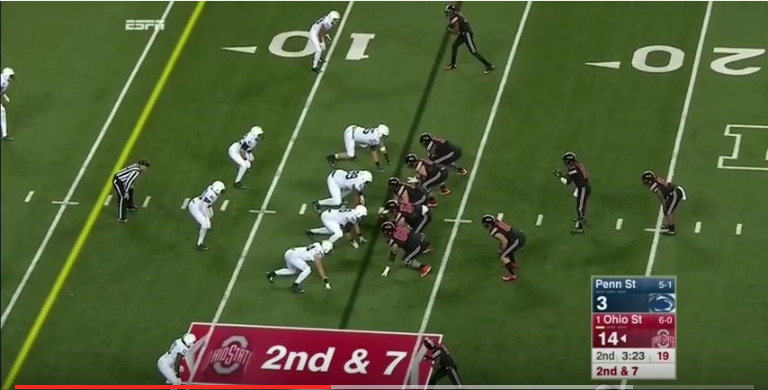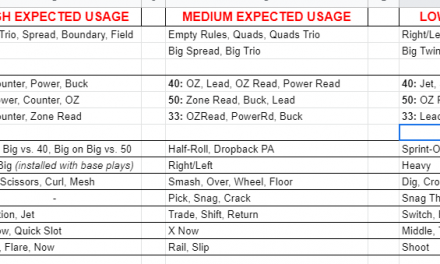We have been running this version of the slow slip screen since 2013 when our current offensive staff came together, and the nuts and bolts of it were created by our current head coach Alex Garvin and QB Coach Casey Fisher. When I became the offensive coordinator, I got to put a few of my own stamps on it.
Coach Garvin, fortunately, took on the role of the assistant OL coach to help with our newest addition, Caleb Keeton. Under his watch, our offensive line has flourished, and they put all of the ideas into practice.
This play is not earth-shattering, as every bit of this play was created probably before all of us were born, and is in everybody’s playbook.
I hope the information in this article will allow you to run it both to the field and into the boundary with little adjustment to your version of the play.
I also hope it will teach you some of the nuances of the play taught to me by my staff, which will make it a more consistent big play for you.
PROS
- Most high school football teams do not have big offensive linemen. This allows those teams to actually have the advantage of getting out and running, getting in the way of people as your best player runs with the ball in space
- Defensive lineman, no matter much we run this, have yet to slow down their rush on passing downs. This play then becomes a must-have, because it gets the ball to a player in a 10 on 7 situation, with 4 of their most aggressive players behind the play, most likely physically incapable of catching back up to the ball carrier. Defensive lineman live for the chance to rush the quarterback. We have to do something to counter that.
- It creates frustration when teams bring extra defenders on passing downs. The more they bring when a screen is called, the fewer defenders that have a chance to tackle your back after the pass is completed.
- One slight counting adjustment enables us to not change the rules when running it to the boundary or the field.
- As Steve Sarkisian says, “The player that most often gets lost in the passing game is the running back.” Utilize this to your advantage!
CONS
- It takes practice, probably more time in comparison to the number of times you will run it during the game. Running back timing, QB footwork, salesmanship, and O-Line determination of who they will be blocking takes a lot of study and field time. That being said, the number of big plays we have from this is incalculable. It creates so many touches for your best player without having to block anyone and makes them rethink bringing extra defenders on passing downs.
- You must make sure the running back is patient. It’s easy in practice, but we all know that the kid’s minds and behavior speed-up during the games. It is imperative that the running back does not turn around until he has passed every defensive lineman.
PERSONNEL ADJUSTMENTS
I would suggest you run this play out of any formation that screams PASS to the defense. For this play to have optimal success, they have to be in a mindset that they are going to do whatever they can to get to the quarterback.
SLOW SLIP SCREEN OFFENSIVE LINE PLAY
Our offensive line coach, Caleb Keeton, has written a separate article that discusses the offensive line portion of the play here:
Coaching the Offensive Line Slip Screen
QUARTERBACK PLAY
Our quarterbacks coach, Casey Fisher, teaches our players the following key points when throwing the slow slip screen:
- Eye discipline – Make eye contact with the Free Safety. After you hit your third step, find the TB.
- Footwork – We drop three steps then pause, and retreat two more. We feel that to simply keep dropping would be a “tell” for us since we never run five-step drops. It’s the only pass we practice throwing while retreating.
- Release – I try not to overcoach this. We talk about having a high release, but emphasize “snapping down our follow through” because whenever you tell a QB to have a high release he has a tendency to sail it. Sometimes the less I coach them, the better they do.
RUNNING BACK SCREEN PLAY
- The most important adjustment we made to improve our screen, is to ensure the running back does not turn around until he had passed all of the defensive linemen. We noticed on film that the only way the play was ever stopped was when their Defensive Linemen were able to realize what was happening, change directions, and become part of the play. But when they do not know it is happening and continue their momentum upfield, they are incapable of getting back to the line of scrimmage and becoming a part of the play.
- Running backs must study their pass protection body language, and do exactly what they normally do as they cross the line of scrimmage. Any strange behavior will be noticed by LBs, and they will sniff it out and make a play on the ball, possibly even creating an incompletion or an interception. Nothing can be different until the running back passes the entire defensive line.
- If a Line Backer blitzes to the side of the screen, the TB must chip him before releasing. If he does not, it speeds up the footwork of the QB, and forces him to release the ball prior to the lineman releasing, and sometimes before the defensive lineman passes the running back, which was already mentioned as the most important part of the play. Hitting the blitzing LB with your inside shoulder is best, as the play usually goes outside after the ball is received. This does not remove any of the deceptions of the play, because our big-on-big pass protection always has our TB on a Line Backer, anyway. If you use a full slide with your running back on the End Man On The Line Of Scrimmage (EMOL), you may need to adjust this slightly, both in terms of who blocks who after releasing, and the timing of the release of the offensive lineman. But don’t be discouraged. You will figure out a way to make it work.
RECEIVER PLAY & ADJUSTMENTS THAT ALLOW FOR A MORE DYNAMIC SLOW SLIP SCREEN
- Screen-Pass-Options (SPOs) – Hitches to the field with a TB screen to the boundary (Figure 1). If the defense is playing two over three, there’s no reason to not take a free hitch route. But this can only happen when the screen is run away from you. If as a receiver it is run to you, you must run off to a block to ensure there is space for the running back to run after the catch. You can also run another type of SPO when running your TE Screen (Figure 4). If they are playing two over three, you can throw a Now Screen to your RB and block with your other two WRs. This gives you the same idea, as you can get the opportunity to get an athlete in space, without having to block like you would on most plays.
- Attach a vertical concept or your best concept you run to push DBs back in fear of getting beat deep (Figure 2). A #3 crosser coming from the field toward the boundary can get him to not only push the DB into backpedaling but also get the WR into a position where he can block once the DB realizes it is not a downfield throw.
- Run off to a block (Figure 2) – this is where our WRs will run a Vertical route at about 90% so they do not beat the DB too badly off the ball. Once they come to the realization that the DB is cognizant of something other than a pass play occurring, they stop dead in their tracks, push the DB in front of them with their inside forearm, so they can be between the defender and the ball. This is the best way we have found to force the DB far from the play, while also getting a preferred blocking position.
- If you play man-to-man teams that play 3-over-3 to your trips formation, cracking the Mike LB is a great idea when running slow slip screen to the field (Figure 2). Not only is the Mike LB the MDD defender to a field side TB screen, which makes him the most important player in the blocking scheme, but it also creates a high probability that the #3 defender will run inside, and get sealed by the first offensive lineman that releases, leaving even more room to the field for the running back to maneuver after the catch.
- Now that we have an athletic QB and run more empty, we will keep our TE in the game in a hipped position, so we can pass with our best athletes, yet still have a 6th man (and better blocker) in pass protection. Once we decided to do this, we found we could run the play with zero adjustments, and just teach the TE where he needs to be and when (Figure 3/Figure 4). And the second time we ran it, we actually scored a TD, because they were not ready for it. And why would they be?!! The only player we ever throw the slow slip screen to was 30 yards away from the ball!
CONCLUSION
If you are a team with even a simplistic dropback pass game, has a running back that can catch the ball, or like me, is both hesitant and ignorant on how to fully get your running back involved in your passing game, this is a play that is already in your playbook that is worth trying to improve.
It is a play that our offensive lineman love to hear called, and the running back has a good time being a part of it, especially those used to gaining their yards running the ball into a wall of defenders in between the tackles.
Article Written by Coach Aaron Szabo
Offensive Coordinator, Kings High School, Ohio
LEARN MORE ABOUT THE SLOW SLIP SCREEN
If you are looking to learn more about the slip screen and other complimentary screen plays, check out what Jason McManus teaches about his screen game here:





Comment from a reader:
So receivers are just running off DB’s? We usually keep our PST in to influence DE with pass set and PSG would get 1st 2nd level defender outside hash to #’s. Center has 1st 2nd level alley defender and BSG is rat killer.
If you’re choosing not to use an SPO, it creates more space when WRs run off DBs. We teach them “run off to a block”, which means we run about 90%, and then when we see the DB knows it’s a screen, we stop, and start blocking him. If we come off the line like it’s a run, the DBs sit, and it becomes just a run.
The way you’re describing how you block the screen is how we block our WR screens. But with the TB screen, we feel as if we need more guys in the blocking scheme, especially if any of them get caught up in traffic, because it’s a tighter hitting screen.
Does that help? If not, keep ’em coming!